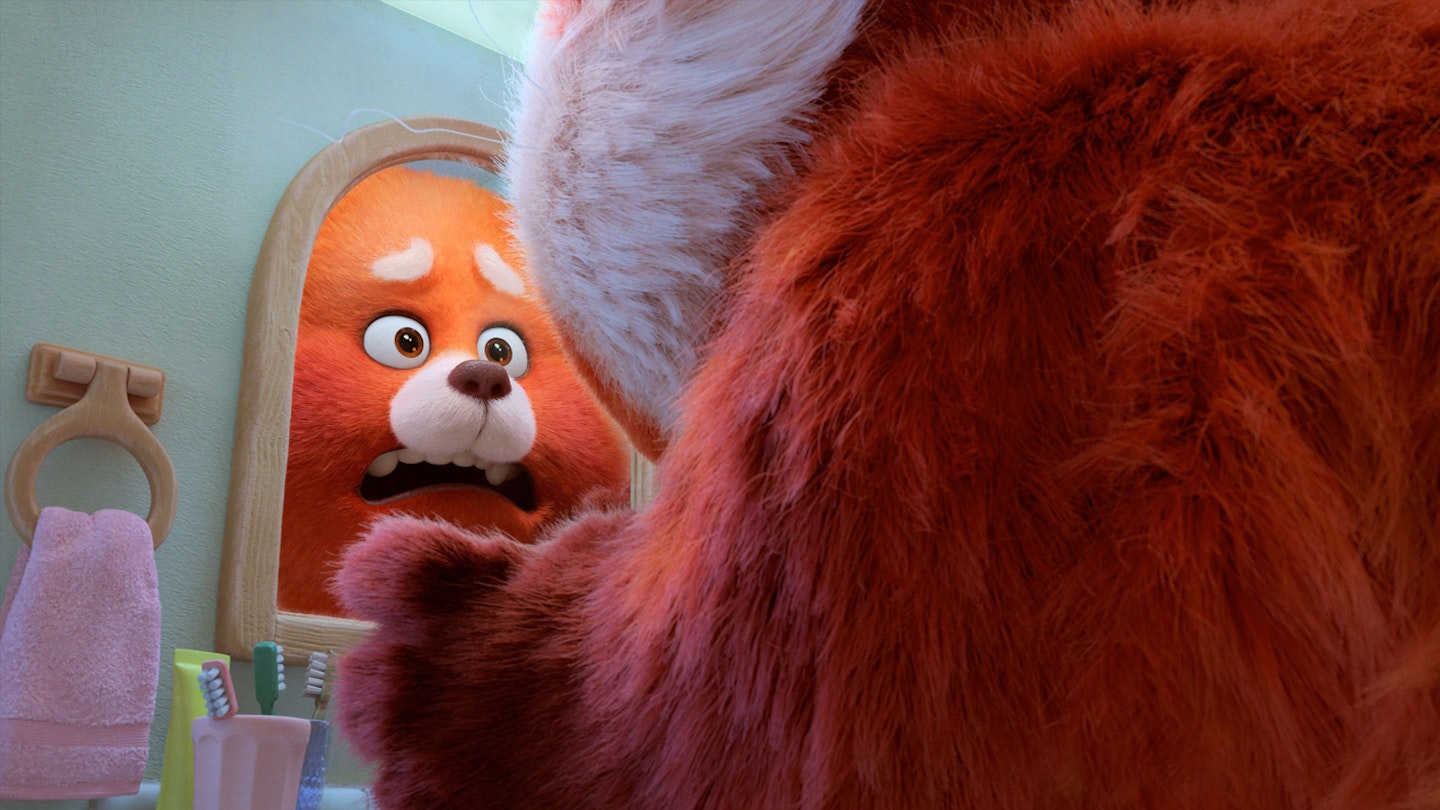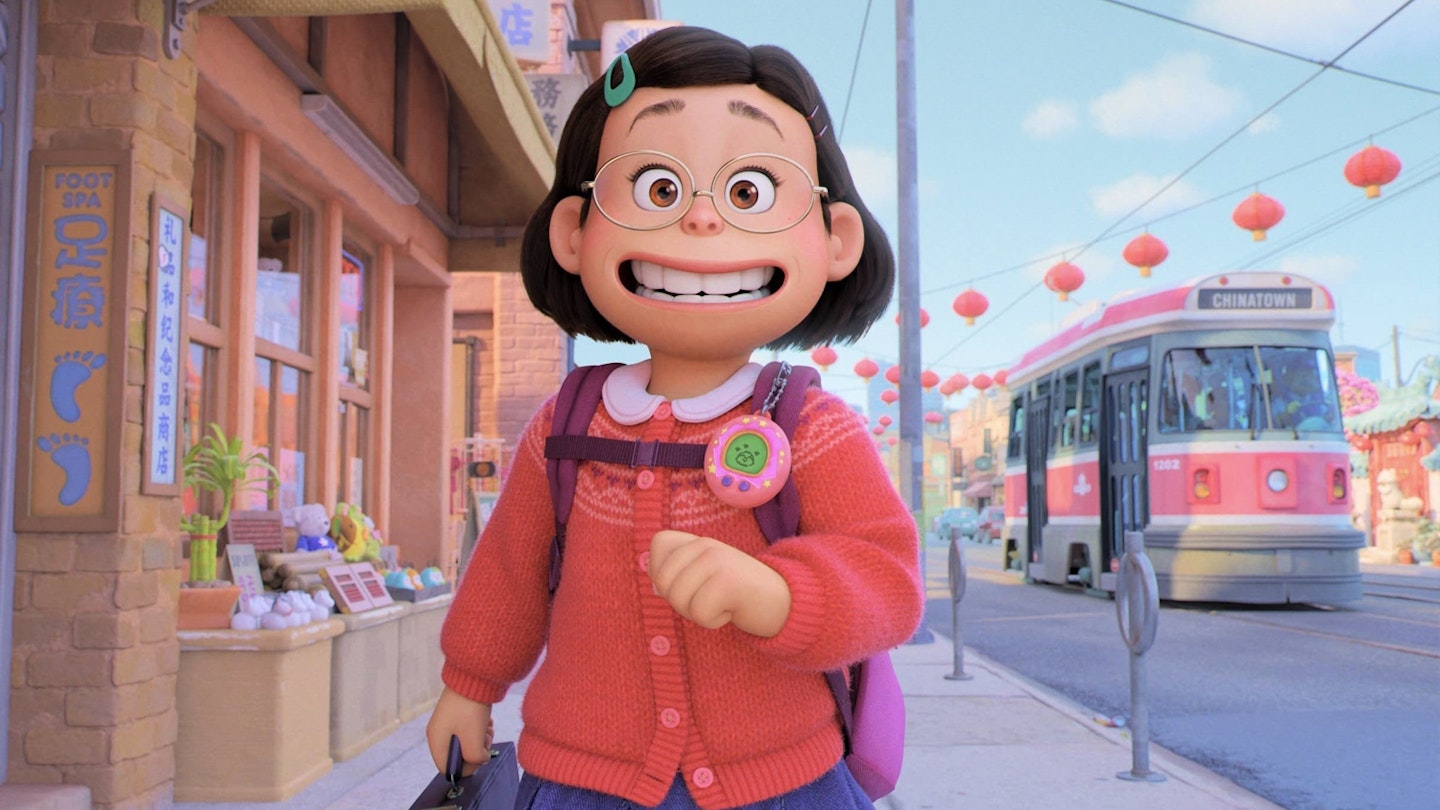Talking toys. Anthropomorphised emotions. Floating houses. If Pixar Animation Studios has a reputation for anything, it’s boundless imagination and creativity. Right from Toy Story and the early shorts, it wasn’t just the innovative 3D animation techniques that set the studio apart – it was the sophistication and subtle smarts of its storytelling, felt in everything from its films’ high concepts (Seven Samurai, with bugs!) to the crackling wit of their screenplays. But for all the inventiveness on show, the studio also settled into a familiar formula – a house visual style and traditional character dynamics – felt even in its wildest films. Until now. Enter Turning Red, the directorial debut of Domee Shi, previously behind the Oscar-winning short Bao. With her first Pixar feature, Shi has created something that looks, sounds, and feels unlike any other film from the studio – one that tears up the rulebook, and rebuilds Pixar in its own style. Welcome to Pixar 2.0.
The most immediate change is that all-new visual approach, apparent right from Turning Red’s opening reel. Set in Toronto in 2002 (which terrifyingly now counts as a period setting), the film centres on Chinese-Canadian teen Mei (Rosalie Chiang), who encounters what Shi calls a “magical puberty” at the age of 13: she starts transforming into a super-sized red panda, a physical expression of her bodily and emotional transition from dutiful daughter to autonomous teenage girl. From the very first scene, this is Mei’s film – in a rare Pixar move, she begins proceedings by breaking the fourth wall, inviting the viewer directly into her world: her confident outlook, her proficiency with the flute, her beloved Tamagotchi, and her talent for maths. With the crash-zoom quick-cut montages of an Edgar Wright movie, distinctive rounded character models, and Chiang’s enthusiastic voice performance, there’s an all-new energy at play here – soft and playful, but punchy and kinetic too.

It's a sense that only gets stronger through the course of the film. With a predominantly pastel-pink palette, face-filter emoji reaction shots, and the glowing aura afforded to Mei’s beloved boyband faves 4TOWN_, _Turning Red is unabashed in reclaiming and celebrating the aesthetic of teen girldom. “The term we used a lot in production was, ‘Asian tween fever dream’,” Shi tells Empire. “From the very beginning, we really wanted this movie to look and feel different – to feel like it’s shot from the point of view of a 13-year-old Asian, dorky, bubbly girl.”
The coming-of-age themes of the story don’t give way to a quest narrative – from beginning to end, this is a film that never strays from Mei’s journey to owning this new part of herself.
To achieve that look, Shi looked back to her own adolescence (she was a tween in early-‘00s Toronto, too), and the array of pop cultural influences she was raised on. Mei’s inner and outer worlds are “also just my own personal aesthetic,” Shi explains. “I was raised with one foot in both Eastern and Western art and culture – I was as influenced by Disney and Warner Bros cartoons as I was with anime and Hayao Miyazaki films. And when you watch the movie, it's a blend of East and West, because I am a blend of East and West.” While the prevailing visual style is still that of mainstream American animation, Turning Red also bears clear anime influences – from exaggerated character reaction shots, to moments of speed-line-accentuated action. “Specifically, I love the anime from the '90s and early 2000s,” Shi says. “Sailor Moon was a huge inspiration for us in terms of the colour palette, but also the expressions, and that teen-girl feeling. Ranma ½ [was an inspiration] for the fight sequences, and the fun of characters poofing into animals and poofing back into humans.”

Those early ‘00s visual reference points are also carried through to Turning Red’s effervescent soundtrack. The uber-catchy 4TOWN songs – an homage to NSYNC and the Backstreet Boys – are penned by Gen Z icon Billie Eilish and her producer and co-writer brother Finneas (artists who themselves are huge with people Mei’s age today), while the score is pure Ludwig Göransson – combining his talents for cinematic orchestration with his background as a hip-hop producer. The result is a musical accompaniment that flutters with traditional Chinese arrangements, underpinned by head-bobbing bass beats, all with an added early-‘00s boyband sheen. Or, as Shi describes it: “Cutesy new jack swing, with dorky jazz flutes!” It was all part of the brief to get inside Mei’s head, explains producer Lindsey Collins. “[We gave Ludwig] that same kind of vision, to give him permission to think about how [Mei] would have scored her own introduction,” she says. “When she looks to camera and introduces herself, it’s like he really leaned into, ‘Alright, if this was Mei giving me notes on what she wanted her theme to be, what would it be?’ He was awesome – he totally got it.”
All of the audio-visual reinvention results in a film that looks and sounds markedly different to anything else in the Pixar canon – but it all comes from a place of serving Mei’s character journey. “She's feeling very strong emotions, and we're really pushing and exaggerating her facial features, the colours, really pushing the background and abstracting it,” says Shi, “and really making it clear that whatever she's feeling, we, as the audience, are feeling it too with all the colours and the compositions.” Because if there’s a notable way Turning Red breaks Pixar’s storytelling mould, it’s that the coming-of-age themes of the story don’t give way to a quest narrative – from beginning to end, this is a film that never strays from Mei’s journey to owning this new part of herself.
Pixar has produced some of the greatest animated movies ever made – but Turning Red proves there are still so many kinds of stories left for them to tell.
Even Pixar’s most boundary-pushing work – the opening half hour of Wall-E, the globe-trotting magical realism of Up, the literal emotional intelligence of Inside Out – eventually gives way to some kind of adventure story. See Wall-E’s mission to preserve the last piece of viable plant life on Earth, or elderly Carl’s airborne dogfight against fellow adventurer Charles Muntz, or Joy and Sadness’ journey through Riley’s subconscious to get back to the control room. Turning Red isn’t just a rare Pixar film that isn’t a buddy movie – there’s no Sully to Mei’s Mike, no Dory to her Marlin, no Linguine to her Remy – but it also doesn’t send her off through the neighbourhoods of Toronto, or devise a MacGuffin for her to collect.
In fact, its story around the arrival of Mei’s new panda form isn’t even about keeping that identity secret or under control – it’s about how she chooses to embrace it. “I was trying, from the very beginning, not to go the more predictable route of Mei trying to hide her secret panda identity for the majority of Act Two, and having it blow up,” confirms Shi. “This was about a girl owning her red panda-ness, and it was more about her conflict and relationship with her mom, versus her relationship with the outside world, and what they thought of the panda.” If there is a monster fight in the final reel, it’s still firmly rooted in Mei’s changing relationships with her mother Ming (Sandra Oh), her closest friends, and herself.
For decades, Pixar has been at the forefront of some of the greatest animated movies ever made – but Turning Red proves there are still so many kinds of stories left for them to tell. “I love coming of age stories, and being a fan of them and seeing so many versions of [them], I really wanted to make this feel unique and different,” says Shi. Turning Red not only succeeds on that front – it might just be the start of a whole new era for the studio.
Turning Red is streaming now on Disney+.
